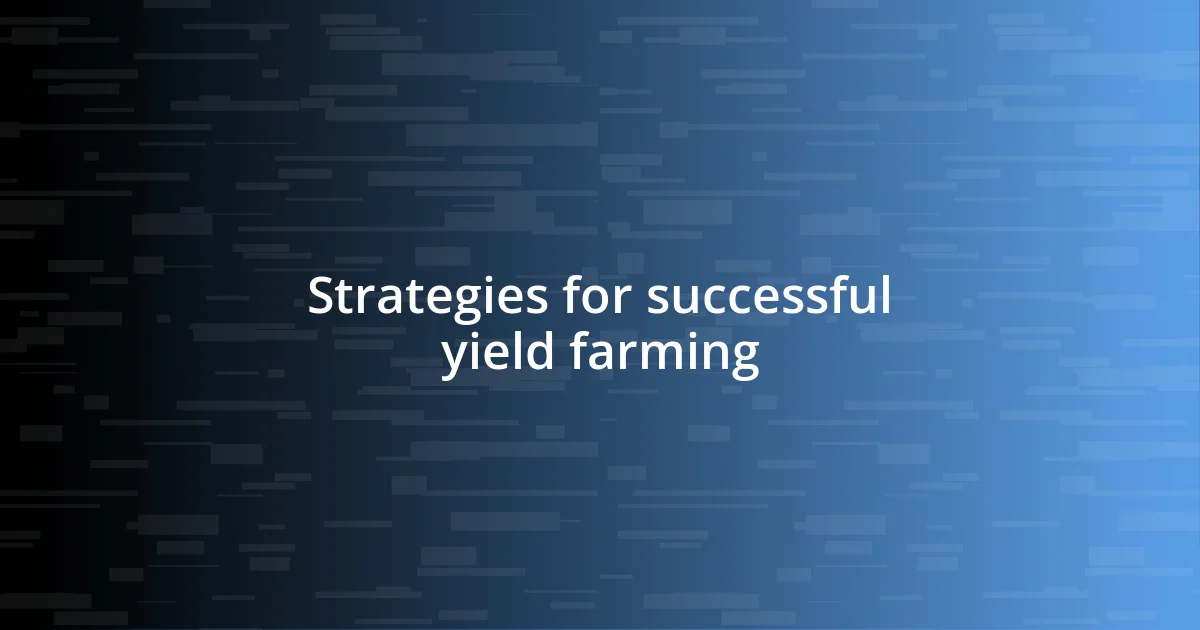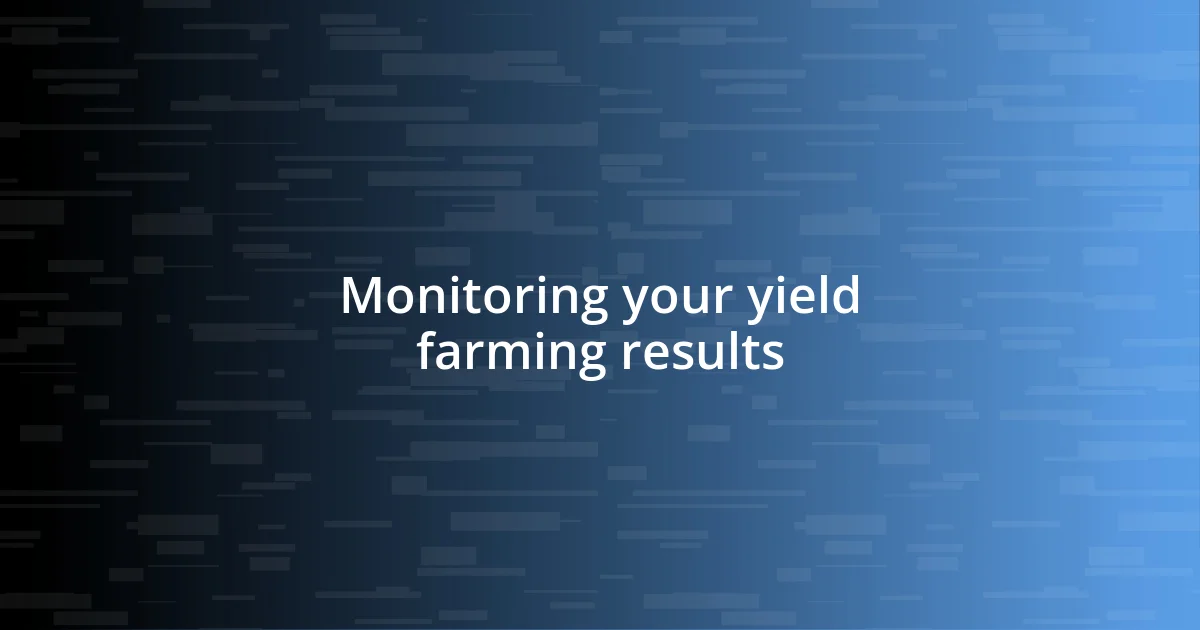Key takeaways:
- Yield farming involves lending cryptocurrency and providing liquidity, but understanding associated risks like impermanent loss and smart contract vulnerabilities is crucial.
- Evaluating yield farming protocols requires careful analysis of metrics, governance models, and development team reputations to make informed investment decisions.
- Successful yield farming strategies include diversification, thorough research, setting clear goals, and consistent monitoring of investment performance to mitigate risks and enhance returns.

Understanding yield farming basics
Yield farming, at its core, is a way to earn rewards on your cryptocurrency holdings by lending them out or providing liquidity for decentralized exchanges. I remember the first time I dived into yield farming; the whole process felt a bit like stepping into a new world where your assets could work harder for you. Isn’t it fascinating how something as simple as pooling funds can unlock potential profits?
One thing I quickly learned is that yield farming often involves navigating various protocols, each with unique rules and incentives. Initially, it felt overwhelming—like trying to read a map in a foreign city. But once I grasped the nuances, I realized that understanding liquidity pools and annual percentage yields (APYs) could significantly change my approach. Have you ever taken the time to really analyze the APY on platforms? It can be a game-changer.
Moreover, it’s crucial to grasp the risks associated with yield farming, like impermanent loss or smart contract vulnerabilities. I felt a rush of anxiety after a near-miss with a protocol that had a security breach—I learned the hard way that doing thorough research is non-negotiable. What about you? How do you balance the thrill of potential gains with the risks that come with it? Every farmer must ask themselves this before they leap into the yield farming landscape.

Evaluating yield farming protocols
Evaluating yield farming protocols requires a blend of attention to detail and strategic thinking. During my initial forays, I often found myself sifting through an overwhelming amount of metrics. One particular protocol caught my eye with its attractive APY, but I later learned that high yields could come with significant risks. Have you ever been drawn in by flashy numbers, only to find hidden pitfalls? I certainly have!
As I started comparing various protocols, I became more discerning about factors like governance models and the reputation of the development team. There’s something reassuring about investing in projects backed by experienced teams with transparent practices. I vividly recall a moment when I chose to back a protocol based on its developers’ active engagement with the community—a decision that brought both security and return. What criteria do you consider important when selecting a protocol?
To sum up my journey of evaluating yield farming protocols, I realized that understanding performance history and risk management tools is indispensable. Tracking metrics over time illuminated trends that helped me fine-tune my investment choices. Over time, this analytical approach transformed my perspective on yield farming from a gamble to an informed strategy. The thrill of the chase was exhilarating, but data-driven decisions paved the path to sustained success.
| Protocol Name | APY (%) |
|---|---|
| Protocol A | 20% |
| Protocol B | 35% |
| Protocol C | 15% |

Strategies for successful yield farming
When it comes to successful yield farming, developing a solid strategy is key. I’ve discovered that diversifying across multiple protocols not only spreads risk but also maximizes potential rewards. There was a time when I put all my assets into one protocol, only to watch it tank after a market dip. That feeling of dread was a wake-up call. Now, I consciously balance my investments, ensuring exposure to various strategies and platforms.
Here are some effective strategies I’ve learned along the way:
- Research Thoroughly: Dive deep into each protocol’s mechanics. Look beyond the APYs.
- Stay Updated: Follow community discussions and updates from the developers. Active engagement often indicates a dedication to improvement.
- Use Data Tools: Utilize analytic platforms to track performance over time. Understanding trends can reveal profitable paths.
- Set Clear Goals: Establish what you want from yield farming—short-term gains, long-term investments, or a mix of both.
- Monitor Market Conditions: Be aware of wider market trends. Changes in the crypto landscape can impact yields drastically.
Sometimes I even set reminders to check in regularly on my investments, so I can pivot quickly if needed. It feels good to be proactive rather than reactive, especially in such a volatile space. Have you ever felt overwhelmed by the sheer number of choices? I know I have, and it taught me to embrace discipline in decision-making.

Managing risks in yield farming
Managing risks in yield farming is crucial. One of the first lessons I learned was the importance of setting limits, particularly on capital allocation. I distinctly remember a phase where I didn’t have any hard stops in place; it felt so liberating at the time, thinking I could just keep reinvesting everything. But then a protocol I trusted faced a sudden exploit, and watching my portfolio plummet was gut-wrenching. Have you ever felt that kind of shock after an unexpected loss? It certainly spurred me to rethink my strategy and prioritize risk management.
Another significant aspect of managing risks is understanding impermanent loss. This concept hit home during a liquidity farming stint where I failed to grasp how market fluctuations could affect my returns. I often found myself daydreaming about potential profits, completely ignoring the possibility of value shifting away from my deposited assets. It was a bitter pill to swallow when I realized that my rewards were being pulled down by the disparity in token prices. I encourage you to educate yourself about these risks before diving in—do not let the allure of high yields cloud your judgment.
Lastly, I’ve become a strong advocate for utilizing insurance protocols. Early on, I thought insurance was just a buzzword, something only serious investors needed to consider. But after experiencing a contract breach, I wished I had a safety net in place to cushion the blow. Now, in every investment decision, I actively look for these options. Have you explored insurance options in your yield farming journey? It can be a game-changer, offering that extra layer of comfort in a realm where volatility reigns.

Monitoring your yield farming results
Monitoring my yield farming results has been a revelation in my crypto journey. In the early days, I would casually glance at my balances but didn’t focus on the details. I remember this one time when I realized I had neglected to track a particular protocol’s changes—my yields had significantly dropped without me even noticing. That sinking feeling pushed me to set up a more structured approach; now, I regularly review performance dashboards and keep my eye on the APYs.
By integrating performance tracking into my routine, I’ve learned to extract valuable insights from the data. I often find myself diving into analytics tools, comparing different protocols and assessing whether they meet my expectations. Have you ever examined why one farm outperforms another? Understanding these nuances can illuminate paths for both optimization and future investments. As a result, I’ve adapted my strategies based on concrete results rather than gut feelings.
I can’t stress enough the importance of emotional detachment in this process. I remember panicking when yields fluctuated dramatically, fearing I’d miss out on potential profits. But, after some reflection, I adopted a system of pre-set intervals to review and adjust my portfolio. This approach has kept my anxiety at bay and allowed me to focus on the metrics that truly matter. So, how do you stay in touch with your farming outcomes? Finding a rhythm that suits your personality and goals is vital for an effective farming experience.














